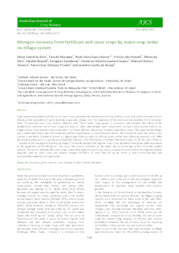Nitrogen recovery from fertilizers and cover crops by maize crop under no-tillage system.
Nitrogen recovery from fertilizers and cover crops by maize crop under no-tillage system.
Author(s): SILVA, E. C. da; MURAOKA, T.; BASTOS, A. V. S.; FRANZINI, V. I.; SILVA, A. da; BUZETTI, S.; SAKADEVAN, K.; SOARES, F. A. L.; TEIXEIRA, M. B.; TRIVELIN, P. C. O.; ARAÚJO, L. C. de
Summary: Crop rotation associated with the use of cover crops promotes the introduction of crop residues to the soil, with direct and indirect effects on theavailability of plant nutrients, especially nitrogen (N). The objectivesof this study wereto estimate the N utilization from15N-ureaand cover crop residues (labelled with 15N)of maizecropsgrown in succession,andevaluate the effectsof the isolated and combined use of cover crops and urea on maize plant height, yield components,andgrain yield, grownunderano-tillage system. Field researchwas conductedin anOxisol (Rhodic Haplustox), Cerrado (Savannah) phase. The experimental design was a randomized block with 20 treatments and four replications in a 5x4 factorial scheme. The treatments were four cover cropsspecies: sunnhemp (Crotalaria juncea L.), pigeon pea (Cajanus cajan(L.) Millsp), green velvetbean (Mucuna prurens),and millet (Pennisetum glaucumL.) + spontaneous vegetation (fallow in the off-season),combined with four N rates: 0, 30, 90,and 150 kg ha-1, applied at the sowing and topdressingstages. The results showed that legume covercropsprovided maize grain yieldsequivalent tothe applicationof 80-108 kg ha-1N as urea. TheureaN utilizationby the maize was at an averageof43.5% of the appliedamount.The results indicatethat cover crops, particularly legume cover crops,are an important source of N to non-legume cereals.Legumes used as cover crops can replace nitrogen fertilizers of more than 80 kg ha, which is both environmentally and economically viable for corn production.
Publication year: 2020
Types of publication: Journal article
Unit: Embrapa Maranhão
Observation
Some of Embrapa's publications are published as ePub files. To read them, use or download one of the following free software options to your computer or mobile device. Android: Google Play Books; IOS: iBooks; Windows and Linux: Calibre.
Access other publications
Access the Agricultural Research Database (BDPA) to consult Embrapa's full library collection and records.
Visit Embrapa Bookstore to purchase books and other publications sold by Embrapa.

